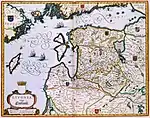Principality of Jersika
The principality of Jersika (Latin: Gerzika, terra Lettia, German: Gerzika, Zargrad, Russian: Ерсика, Герцике; also known as Лотыголa) was an early medieval Latgalian principality in eastern modern-day Latvia and one of the largest early states in Latvia before the German conquests. The capital of Jersika was located on a hill fort 165 km (103 mi) southeast of Riga.
Principality of Jersika terra Lettia Лотыголa | |||||||||
|---|---|---|---|---|---|---|---|---|---|
| before 1000–1239 | |||||||||
 Map of Principality of Jersika and its border speculations. | |||||||||
| Capital | Jersika | ||||||||
| Common languages | Ancient Latgalian | ||||||||
| Religion | Orthodox Church, Paganism | ||||||||
| Government | Principality | ||||||||
| Prince (rex) | |||||||||
| History | |||||||||
• Established | before 1000 | ||||||||
• Disestablished | 1239 | ||||||||
| |||||||||
Part of a series on the |
|---|
| History of Latvia |
 |
| Chronology |
|
|
History
Jersika was established in the 10th century as an outpost of the principality of Polotsk on the old "trade route from the Varangians to the Greeks". It was ruled by Orthodox Christian princes from the Latgalian-Polotsk branch of the Rurik Dynasty.[1]
In 1209 Visvaldis, the prince of Jersika, was defeated by bishop Albert of Riga and the Livonian Brothers of the Sword, and his Lithuanian wife taken prisoner. He was forced to submit his kingdom to Albert as a grant to the Bishopric of Riga, and received back only a portion of it as a fief. He lost lands of Autīne and Cesvaine, but retained Jersika, Mākoņkalns and Naujiene. Visvaldis' feudal charter is the oldest such document surviving in Latvia, and in this charter Visvaldis is called "the king of Jersika" ("Vissewalde, rex de Gercike", in another document also "Wiscewolodus rex de Berzika").[2]
In 1211 the part of Jersika controlled by Albert which was known as "Lettia" ("terra, quae Lettia dicitur") was divided between the bishopric of Riga and the Livonian Brothers of the Sword.[3] In 1212 Polotsk gave up its tributary rights over Jersika in favor of Bishop Albert. In 1214 Germans attacked the Castle of Jersika and sacked it. Baltic German Uexküll family claimed that Conrad Uexküll had married the daughter of Visvaldis.
After the death of Visvaldis in 1239 his fief passed to the Livonian Order, but this was repeatedly contested by the rulers of Lithuania and Novgorod, who periodically sought to conquer the territory.
References
- von Keussler, Fr. (1897) Zur Geschichte Bischof Meinhards und des Fürstenthums Gercike. Sitzungsberichte der Gesellschaft für Geschichte und Altertumskunde der Ostseeprovinzen Russlands a.d. Jahre 1896. Riga.
- The "Chronicle of Henry of Livonia" translated and edited by James A. Brundage, Columbia University, 1961; revised 2003; 288 pages ISBN 0-231-12888-6
- Švābe, A. (1936) "Jersikas karaļvalsts Archived 2011-09-27 at the Wayback Machine". Senatne un Māksla, 1936:1, pp. 5–31. (In Latvian, original documents in Latin included)